Fattorini H.O., Kerber A. The Cauchy Problem
Подождите немного. Документ загружается.

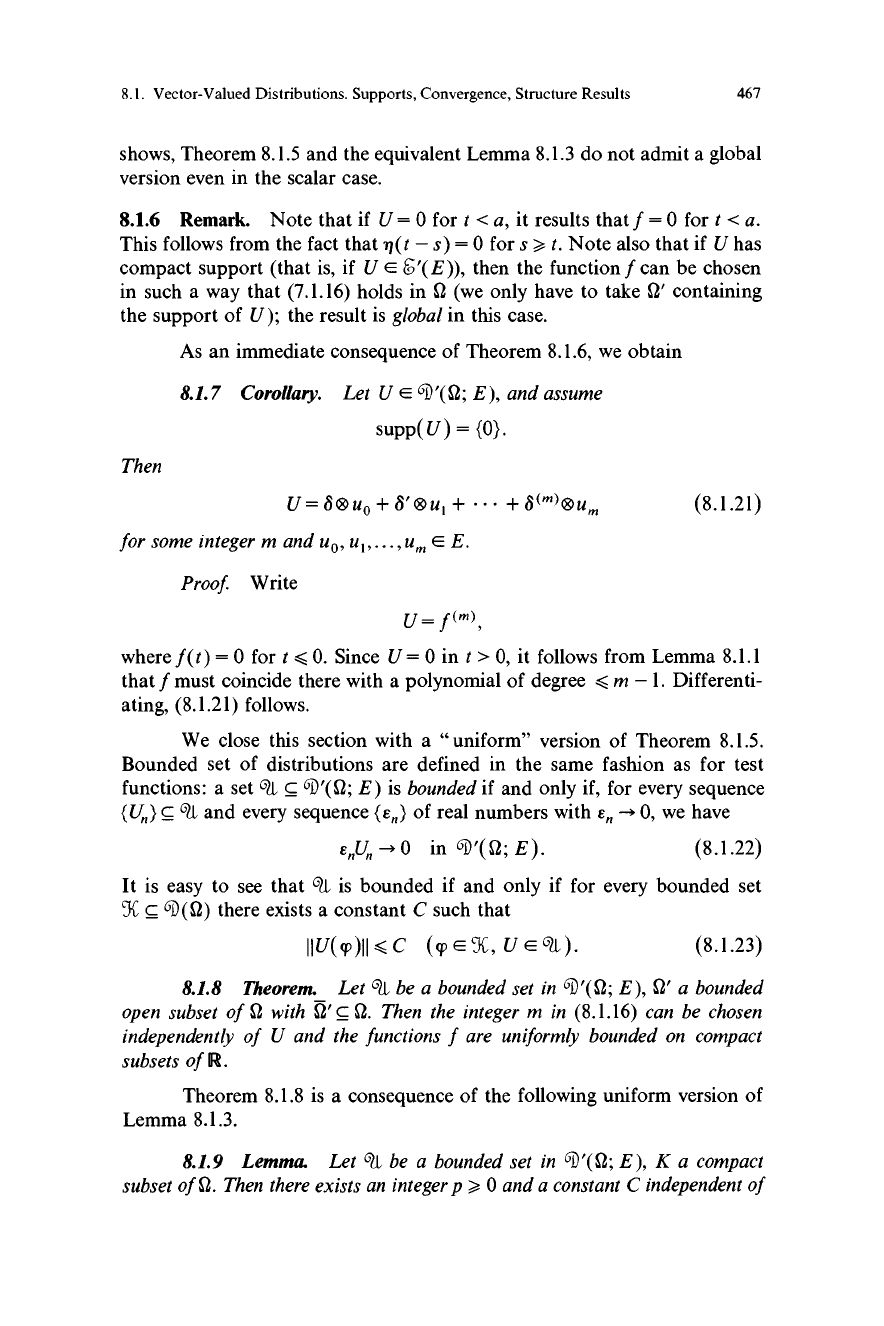
8.1. Vector-Valued Distributions. Supports, Convergence, Structure Results
467
shows, Theorem 8.1.5 and the equivalent Lemma 8.1.3 do not admit a global
version even in the scalar case.
8.1.6 Remark. Note that if U = 0 for t < a, it results that f = 0 for t < a.
This follows from the fact that rl(t - s) = 0 for s >_ t. Note also that if U has
compact support (that is, if U E P(E)), then the function f can be chosen
in such a way that (7.1.16) holds in 0 (we only have to take 2' containing
the support of U); the result is global in this case.
As an immediate consequence of Theorem 8.1.6, we obtain
8.1.7 Corollary. Let U E 6D'(2; E), and assume
supp(U) = (0).
Then
U=S®uo+S'®u,+ +S(m)®um
(8.1.21)
for some integer m and u0, u1,...,um E E.
Proof. Write
U = f(m)
where f (t) = 0 for t < 0. Since U = 0 in t > 0, it follows from Lemma 8.1.1
that f must coincide there with a polynomial of degree < m - 1. Differenti-
ating, (8.1.21) follows.
We close this section with a " uniform" version of Theorem 8.1.5.
Bounded set of distributions are defined in the same fashion as for test
functions: a set Q.L c 6 '(S2; E) is bounded if and only if, for every sequence
C Q?l, and every sequence (en) of real numbers with e - 0, we have
0 in 6 '(S2; E). (8.1.22)
It is easy to see that Xt is bounded if and only if for every bounded set
`JC c 6 (S2) there exists a constant C such that
IIU(T)II<C (p EX, UE'21,).
(8.1.23)
8.1.8
Theorem. Let 6k be a bounded set in 6 '(S2; E), SZ' a bounded
open subset of S2 with n' c Q. Then the integer m in (8.1.16) can be chosen
independently of U and the functions f are uniformly bounded on compact
subsets of R.
Theorem 8.1.8 is a consequence of the following uniform version of
Lemma 8.1.3.
&1.9 Lemma.
Let X..L be a bounded set in 6D'(2; E), K a compact
subset of Q. Then there exists an integer p > 0 and a constant C independent of
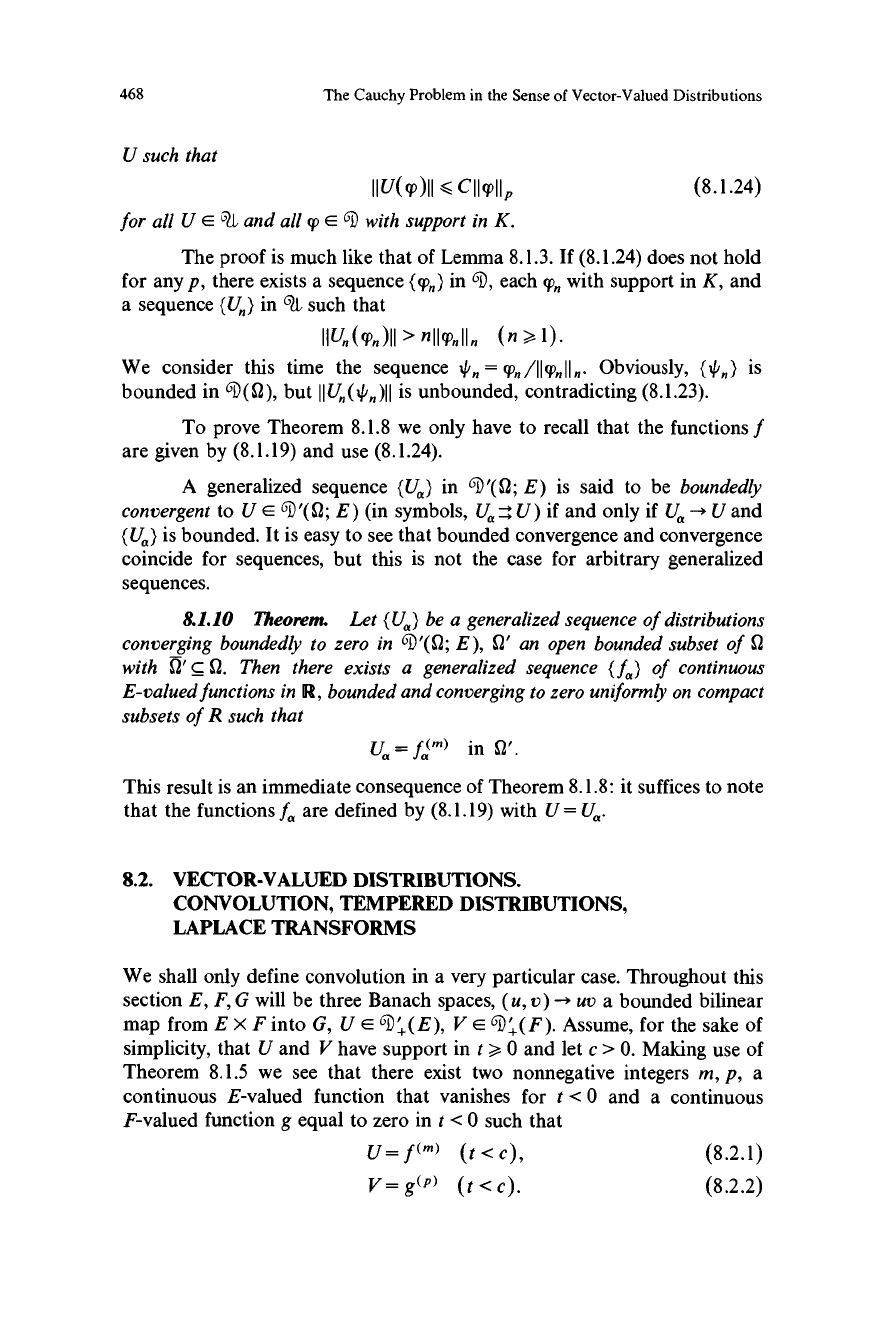
468
The Cauchy Problem in the Sense of Vector-Valued Distributions
U such that
II00II<C1101,
(8.1.24)
for all U E 2L and all p E 6D with support in K.
The proof is much like that of Lemma 8.1.3. If (8.1.24) does not hold
for any p, there exists a sequence {q),,) in 6D, each qq with support in K, and
a sequence
in 6k such that
IIU,,(T,,)II>nII'p II,,
(n>,1).
We consider this time the sequence Jn = %, /I I (Pn I I
n
Obviously, (i n) is
bounded in 6D(0), but is unbounded, contradicting (8.1.23).
To prove Theorem 8.1.8 we only have to recall that the functions f
are given by (8.1.19) and use (8.1.24).
A generalized sequence (Ua) in 61'(S2; E) is said to be boundedly
convergent to U E 6 '(Sl; E) (in symbols, Ua - U) if and only if Ua - U and
(Ua) is bounded. It is easy to see that bounded convergence and convergence
coincide for sequences, but this is not the case for arbitrary generalized
sequences.
8.1.10
Theorem.
Let (U,) be a generalized sequence of distributions
converging boundedly to zero in 6 '(S2; E), Sl' an open bounded subset of Sl
with D' C: Q. Then there exists a generalized sequence (fa) of continuous
E-valued functions in R, bounded and converging to zero uniformly on compact
subsets of R such that
Ua= f(m)
in Sl'.
This result is an immediate consequence of Theorem 8.1.8: it suffices to note
that the functions fa are defined by (8.1.19) with U = Ua.
8.2. VECTOR-VALUED DISTRIBUTIONS.
CONVOLUTION, TEMPERED DISTRIBUTIONS,
LAPLACE TRANSFORMS
We shall only define convolution in a very particular case. Throughout this
section E, F, G will be three Banach spaces, (u, v) - uv a bounded bilinear
map from E X F into G, U E 6
' (E), V E' +(F). Assume, for the sake of
simplicity, that U and V have support in t >, 0 and let c > 0. Making use of
Theorem 8.1.5 we see that there exist two nonnegative integers m, p, a
continuous E-valued function that vanishes for t < 0 and a continuous
F-valued function g equal to zero in t < 0 such that
U = f(m)
(t < c), (8.2.1)
V=g(p)
(t < c).
(8.2.2)

8.2. Convolution, Tempered Distributions, Laplace Transforms
469
We define
U*V=(f*g)lm+P)
(8.2.3)
in t < c, that is, for every (p E 6D with support in (- oo, c). Here f * g is the
ordinary convolution off and g,
(f*g)(t)_ ff(t-s)g(s)ds, (8.2.4)
where the interval of integration is actually 0 < s < t. (Note that f * g is
continuous.) Since c may be arbitrarily large, it is clear that the definition
above works for any (p E 6D, but it is not immediately apparent that it does
not depend on the choice of the representations (8.2.1) and (8.2.2), which
are obviously not unique. Assume, say, that we replace (8.2.1) by
U=f,(mi)
(t <c1).
We may assume that m < m, and c < c, (the other possibilities are dealt
with in a similar way). Since (f - fl" m))(m) = 0 in t < c, it follows from
Lemma 8.1.1 that f - f i m 1 - m) is a polynomial in t < c. But both f and f, are
zero for t < 0, thus f = flmi-m) and f, is continuously differentiable
at least
m, - m times in t < c. Then we have, after a clearly permissible differentia-
tion under the integral sign,
(fl * g)" =
(fl(m'-m) * g)(m)
= (f * g)(m)
in t < c. This proves that U * V is defined independently of the particular
representations (8.2.1), (8.2.2) chosen. The definition can be easily extended
to the case where U = 0 for t < a, V = 0 for t < b; we omit the details.
It is a rather simple consequence of the construction of U * V that
(U * V)(k) = U(k) * v= U * V(k) (8.2.5)
for any U, V and any integer k >, 0.
It can also be easily seen that if U = 0 in t < a and V = 0 in t < b,
then U * V = 0 in t < a + b. On the other hand, assume that U = 0 fort > a'
and V = 0 for t > b'. Take c so large that the interval t < c contains both the
supports of U and V. Then the function fin (8.2.1) must be a polynomial of
degree < m -1 in t > a' and g must likewise be a polynomial of degree
< p - 1 in t > b'. Hence f * g is a polynomial of degree < m + p -1 in
t > a' + b', which implies that U * V = 0 in t >, a' + b'. We can summarize
these observations in the formula
(supp(U* V))`c (suppU)`+(supp(V))(8.2.6)
where (
)`' indicates convex hull.
It is immediate from its definition that the map (U, V) --> U * V from
6D +(E) x 6 +(F) into 6D +(G) is bilinear. We also have the following con-
tinuity property:
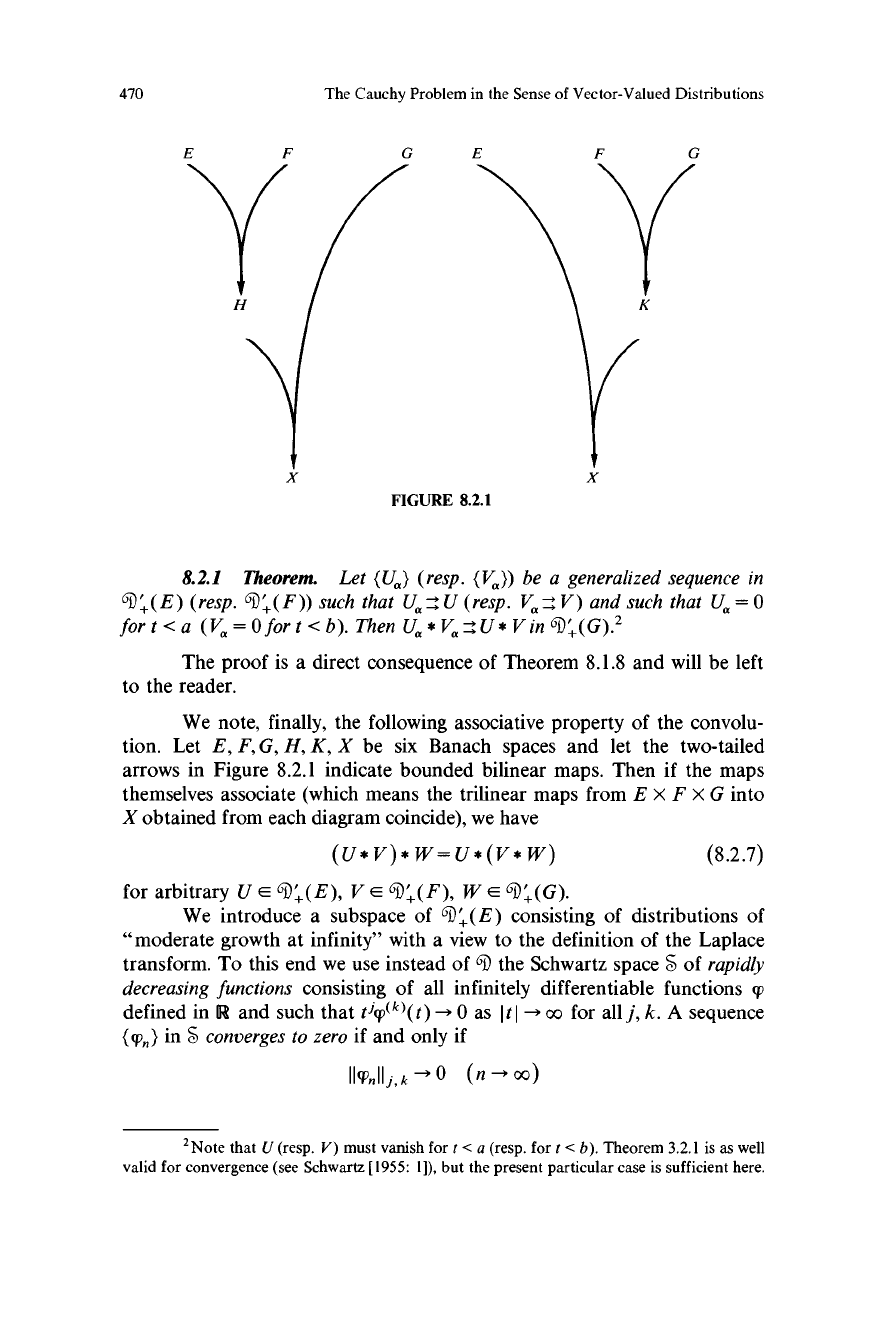
470 The Cauchy Problem in the Sense of Vector-Valued Distributions
FIGURE 8.2.1
8.2.1
Theorem.
Let (Ua) (resp. (V,)) be a generalized sequence in
6D+(E) (resp. 6 +(F )) such that Ua U (resp. Va ; V) and such that Ua = O
fort <a (Va=O fort<b).Then Ua*Va-_ U*Vin 6D' (G).Z
The proof is a direct consequence of Theorem 8.1.8 and will be left
to the reader.
We note, finally, the following associative property of the convolu-
tion. Let E, F, G, H, K, X be six Banach spaces and let the two-tailed
arrows in Figure 8.2.1 indicate bounded bilinear maps. Then if the maps
themselves associate (which means the trilinear maps from E X F X G into
X obtained from each diagram coincide), we have
(U*V)*W=U*(V*W) (8.2.7)
for arbitrary U E 6D'(E), V E 61. +(F), W E 61. +(G).
We introduce a subspace of 6 +(E) consisting of distributions of
"moderate growth at infinity" with a view to the definition of the Laplace
transform. To this end we use instead of 6D the Schwartz space S of rapidly
decreasing functions consisting of all infinitely differentiable functions (V
defined in O and such that tJg)(k) (t) -. 0 as ItI - oo for all j, k. A sequence
in 5 converges to zero if and only if
IIT,,IIj,k - 0
(n -* oo)
2Note that U (resp. V)
must vanish fort < a (resp. fort < b). Theorem 3.2.1 is as well
valid for convergence (see Schwartz [1955: I]), but the present particular case is sufficient here.
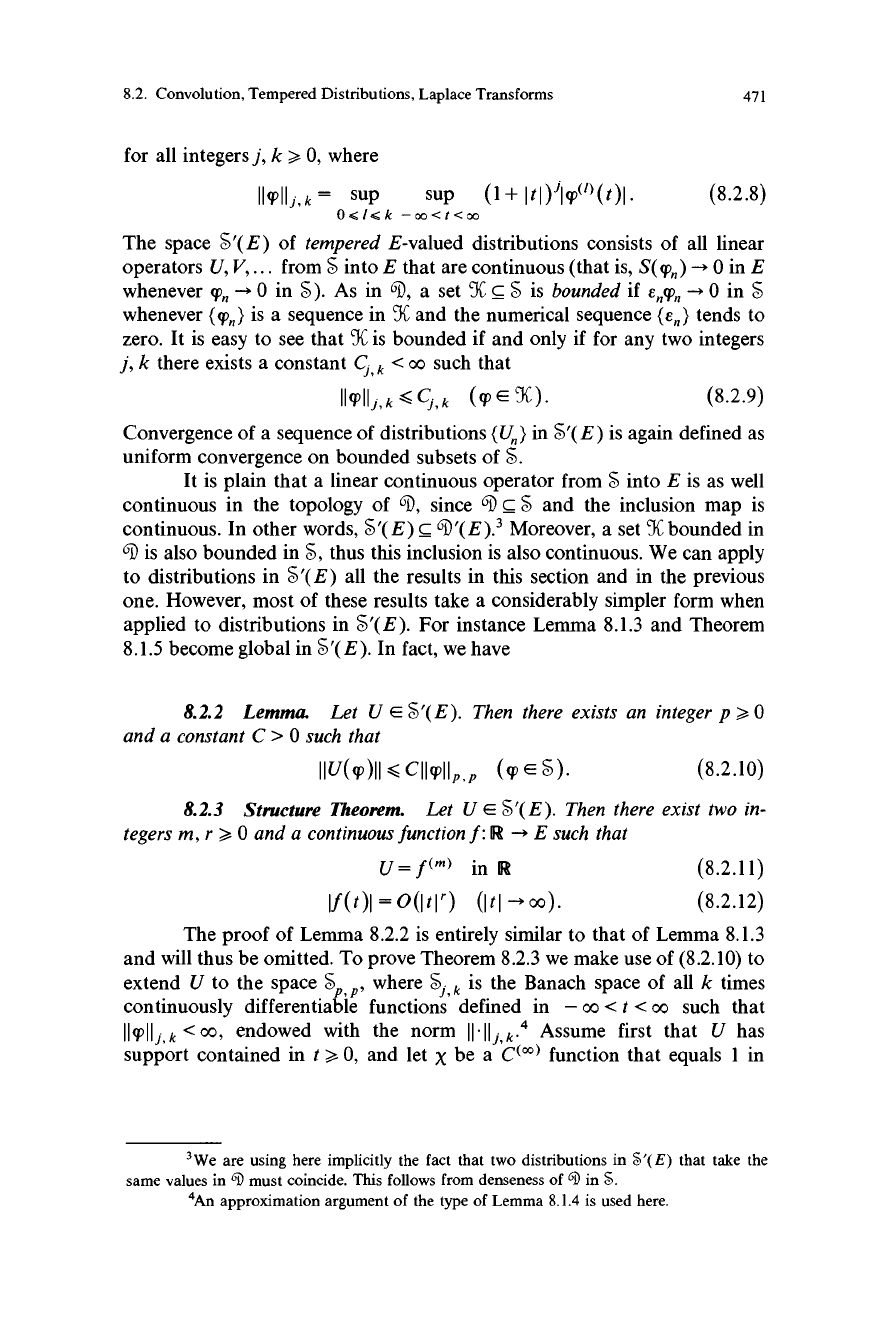
8.2. Convolution, Tempered Distributions, Laplace Transforms
471
for all integers j, k >, 0, where
IIroIIj,k=
SUP
SUP
(l+ 1t1)'Iq)1')(t)I
(8.2.8)
0-<I-<k -oo<t<oo
The space S'(E) of tempered E-valued distributions consists of all linear
operators U, V,... from 5 into E that are continuous (that is, S(q)n) -* 0 in E
whenever qqn - 0 in S). As in 6D, a set Yu c 5 is bounded if r,,cp - 0 in S
whenever {q)n) is a sequence in X and the numerical sequence (en) tends to
zero. It is easy to see that `3C is bounded if and only if for any two integers
j, k there exists a constant Cj, k < 00 such that
IIPIIj,k<Cjk
(TE=X) (8.2.9)
Convergence of a sequence of distributions (Un) in 5'(E) is again defined as
uniform convergence on bounded subsets of S.
It is plain that a linear continuous operator from 5 into E is as well
continuous in the topology of 6D, since 6D c S and the inclusion map is
continuous. In other words, S'(E) c
6D'(E).3 Moreover,
a set 3C bounded in
6D is also bounded in S, thus this inclusion is also continuous. We can apply
to distributions in 5'(E) all the results in this section and in the previous
one. However, most of these results take a considerably simpler form when
applied to distributions in 5'(E). For instance Lemma 8.1.3 and Theorem
8.1.5 become global in eS'(E). In fact, we have
8.2.2
Lemma.
Let U E S'(E). Then there exists an integer p > 0
and a constant C > 0 such that
IIU(q))II < CIIq)IIP,P (p E g)
(8.2.10)
8.2.3
Structure Theorem.
Let U E S'(E). Then there exist two in-
tegers m, r > 0 and a continuous function f : R - E such that
U = f(m)
in R (8.2.11)
If(t)I=o(ItI') (It1_00).
(8.2.12)
The proof of Lemma 8.2.2 is entirely similar to that of Lemma 8.1.3
and will thus be omitted. To prove Theorem 8.2.3 we make use of (8.2.10) to
extend U to the space SP,P, where Sj,k is the Banach space of all k times
continuously differentiable functions defined in - oo < t < oc such that
I l9 l l j, k < oo, endowed with the norm HIM 4 Assume first that U has
support contained in t > 0, and let X be a Cfunction that equals 1 in
3 We are using here implicitly the fact that two distributions in 5'(E) that take the
same values in 6t must coincide. This follows from denseness of 6
in 5.
4An approximation argument of the type of Lemma 8.1.4 is used here.
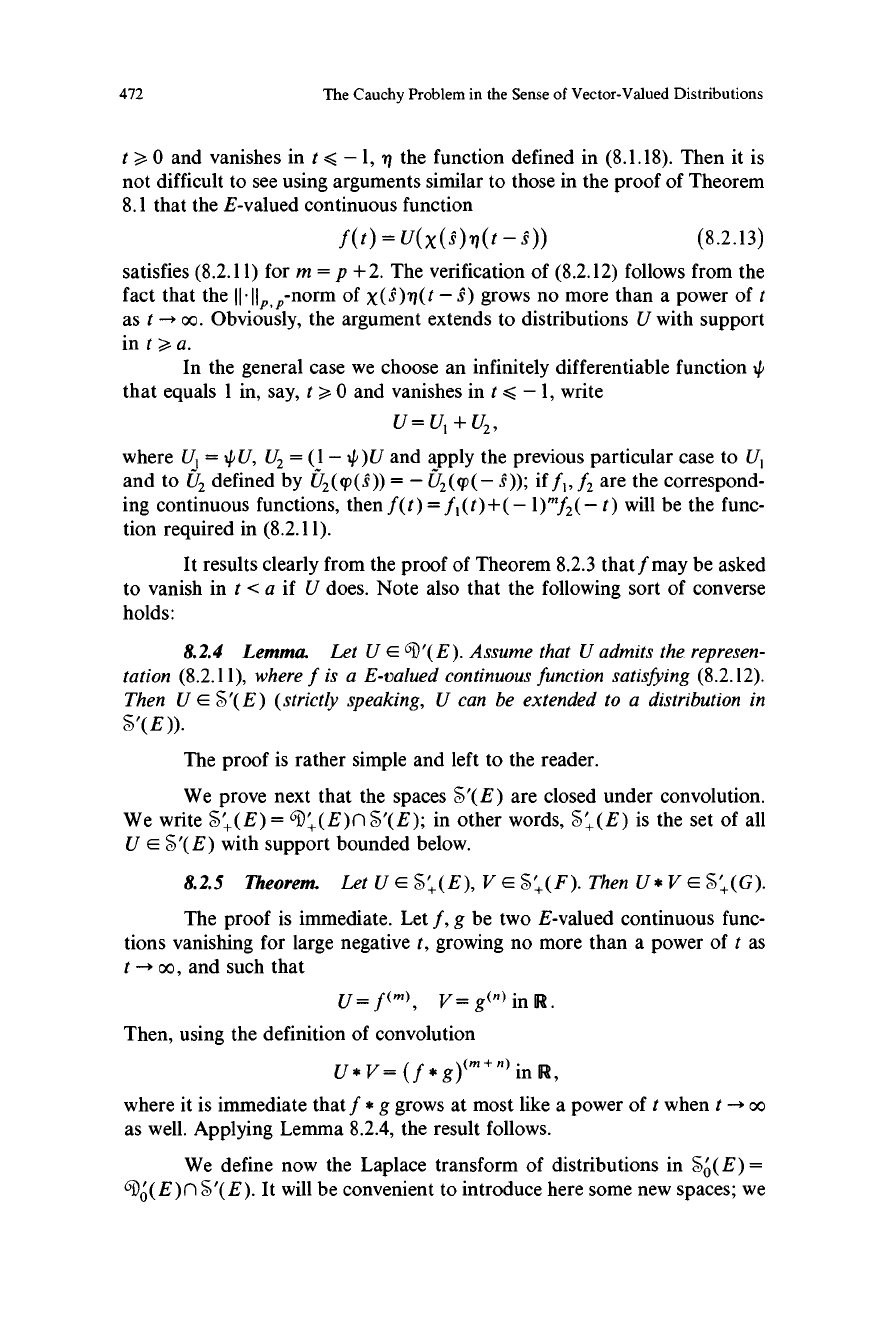
472
The Cauchy Problem in the Sense of Vector-Valued Distributions
t >, 0 and vanishes in t < - 1, rt the function defined in (8.1.18). Then it is
not difficult to see using arguments similar to those in the proof of Theorem
8.1 that the E-valued continuous function
f(t)=U(X(s)'q(t-s)) (8.2.13)
satisfies (8.2.11) for m = p + 2. The verification of (8.2.12) follows from the
fact that the 11 - I I
p, n-norm
of X(9)71(t - s) grows no more than a power of t
as t - oo. Obviously, the argument extends to distributions U with support
in t>, a.
In the general case we choose an infinitely differentiable function
that equals 1 in, say, t > 0 and vanishes in t < - 1, write
U=U,+U2,
where U, = 4 U, U2 = (1- 4i) U and apply the previous particular case to U,
and to U2 defined by U2(((s)) = - U2(4p (- s)); if f f2 are the correspond-
ing continuous functions, then f(t) = f,(t)+(-1)mf2(- t) will be the func-
tion required in (8.2.11).
It results clearly from the proof of Theorem 8.2.3 that f may be asked
to vanish in t < a if U does. Note also that the following sort of converse
holds:
8.2.4
Lemma. Let U E 6D'( E ). Assume that U admits the represen-
tation (8.2.11), where f is a E-valued continuous function satisfying (8.2.12).
Then U E S'(E) (strictly speaking, U can be extended to a distribution in
S'(E))
The proof is rather simple and left to the reader.
We prove next that the spaces cS'(E) are closed under convolution.
We write S+(E) _ 6 +(E)n,5'(E); in other words, 5'(E) is the set of all
U E S'(E) with support bounded below.
8 . 2 . 5 T h e o r e m .
Let U E S' (E), V E S+(F). Then U* V E S' (G).
The proof is immediate. Let f, g be two E-valued continuous func-
tions vanishing for large negative t, growing no more than a power of t as
t --> oo, and such that
U=f(m)
V=g(n)inR.
Then, using the definition of convolution
U* V= (f *
g)(m+n)
in i,
where it is immediate that f * g grows at most like a power of t when t - 00
as well. Applying Lemma 8.2.4, the result follows.
We define now the Laplace transform of distributions in 50'(E) _
6D0'6D( E) n S'(E ). It will be convenient to introduce here some new spaces; we
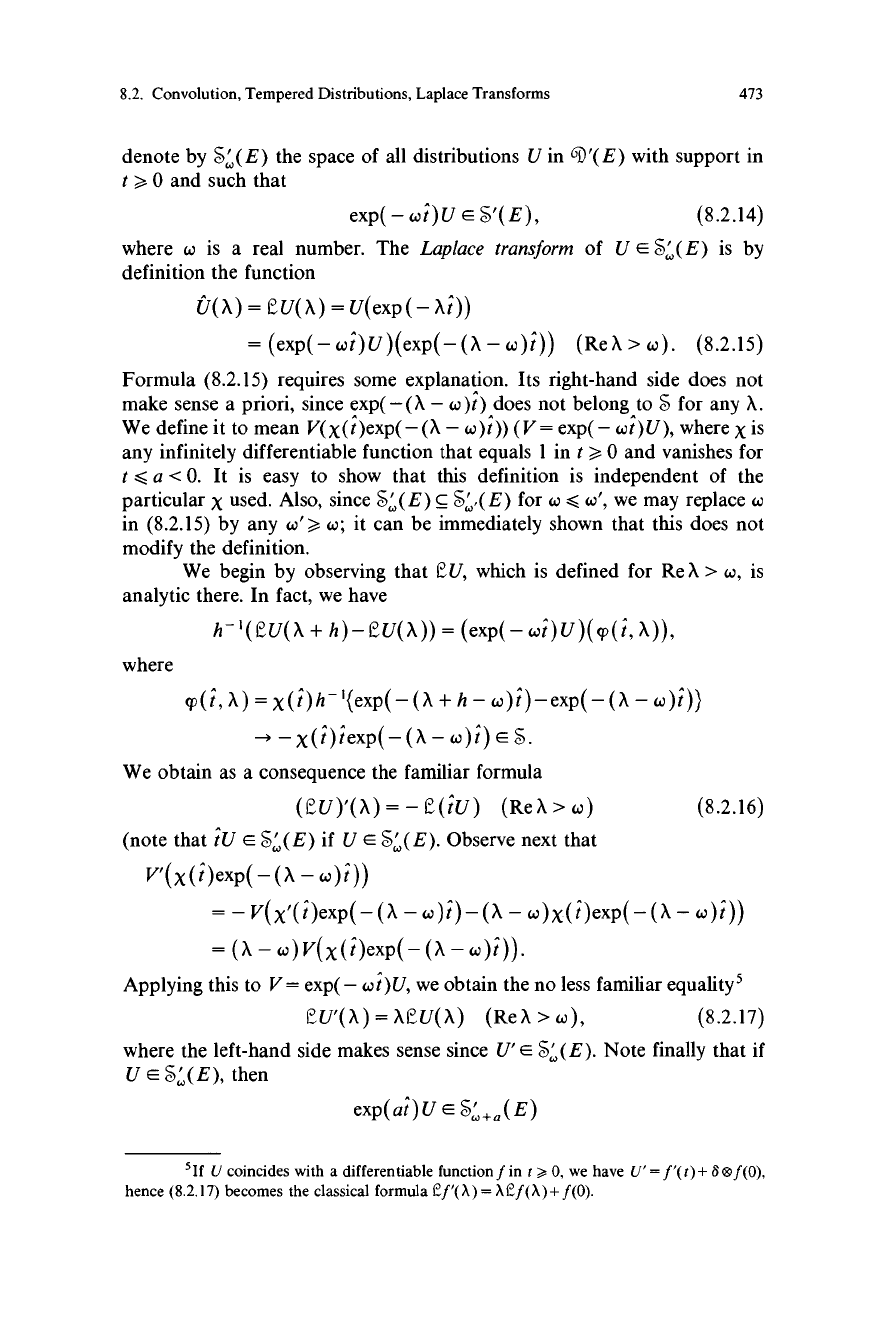
8.2. Convolution, Tempered Distributions, Laplace Transforms 473
denote by 5'(E) the space of all distributions U in 6 '(E) with support in
t >, 0 and such that
exp(- wi) U E S'(E),
(8.2.14)
where w is a real number. The Laplace transform of U E S,,(E) is by
definition the function
U(A) = LU(A) = U(exp(- At))
=(exp(-wt)U)(exp(-(A-w)t)) (ReA>w). (8.2.15)
Formula (8.2.15) requires some explanation. Its right-hand side does not
make sense a priori, since exp( - (A - w) t) does not belong to 5 for any A.
We define it to mean V(X(t)exp(-(A - w)t)) (V= exp(- wt)U), where X is
any infinitely differentiable function that equals 1 in t > 0 and vanishes for
t < a < 0.
It is easy to show that this definition is independent of the
particular X used. Also, since S;, (E) c %.(E) for w < w', we may replace w
in (8.2.15) by any w'>, w; it can be immediately shown that this does not
modify the definition.
We begin by observing that CU, which is defined for ReA > w, is
analytic there. In fact, we have
h-'(LU(A+ h)-eU(A)) =
(exp(-wt)U)((p(t, A)),
where
p(t, A) = X(t)h-'{exp(-(A+ h - w)t)-exp(-(A- w)t))
-X(t)texp(-(A-w)i)ES.
We obtain as a consequence the familiar formula
(ReA>w)
(8.2.16)
(note that t U E S' (E) if U E %(E). Observe next that
V'(X(t)exp(- (A
- w)t))
=-V(X'(t)exp(-(A-w)t)-(A-w)X(t)exp(-(A-w)t))
_ (A - w)V(X(t)exp(-(A - w)t)).
Applying this to V = exp( - wd )U, we obtain the no less familiar equality5
LU'(A) = AEU(A) (ReA > w), (8.2.17)
where the left-hand side makes sense since U' E=- S' (E). Note finally that if
U E $ (E), then
exp(at)U E %' +a(E)
51f U coincides with a differentiable function f in t 3 0, we have U'= f'(t )+ S Of (0),
hence (8.2.17) becomes the classical formula Lf'(A) = xef(x)+ f(0).
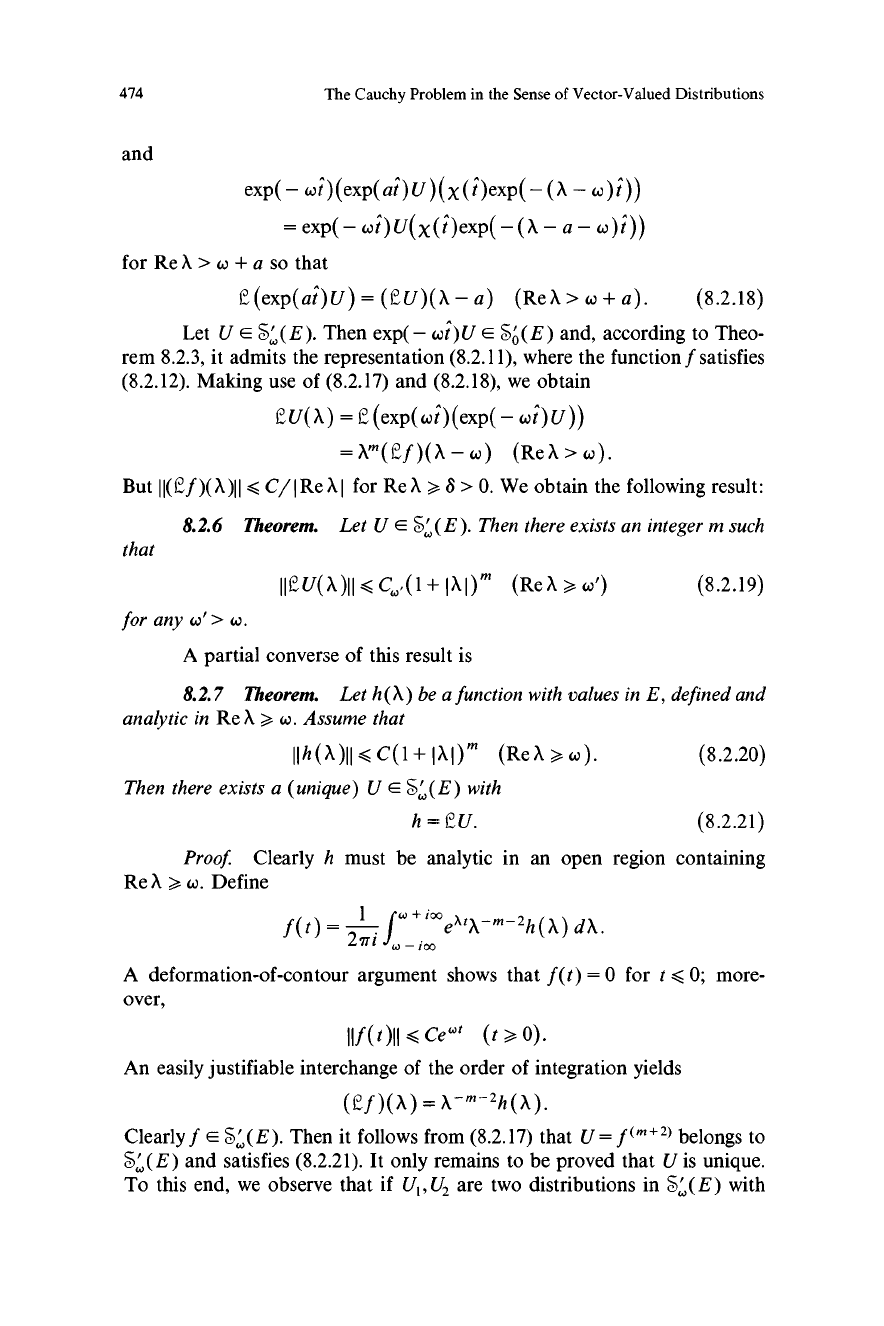
474
The Cauchy Problem in the Sense of Vector-Valued Distributions
and
exp(- wt)(exp(at)U)(X(i)exp(-(A- to) 0)
=exp(-cot)U(X(t)exp(-(A-a-w)t))
for Re A > w + a so that
1(exp(ai)U)=(EU)(A-a) (ReX>w+a).
(8.2.18)
Let U E S; (E). Then exp( - w t) U E o (E) and, according to Theo-
rem 8.2.3, it admits the representation (8.2.11), where the function f satisfies
(8.2.12). Making use of (8.2.17) and (8.2.18), we obtain
LU(X) = e(exp(wt)(exp(- wt) U))
=am(ef)(A-w)
(ReA>co).
But I I(E f )(,\)I I < Cl I Re A I for Re X > 8 > 0. We obtain the following result:
8.2.6
Theorem.
Let U E S' (E ). Then there exists an integer m such
that
IIeU(X)II<C.,(l+IAI)m (ReX,w')
(8.2.19)
for any w'> w.
A partial converse of this result is
8.2.7 Theorem. Let h(A) be a function with values in E, defined and
analytic in Re X >, to. Assume that
IIh(X)II<C(1+IXI)`"
(ReX>,w).
(8.2.20)
Then there exists a (unique) U E 5)(E) with
h=CU.
(8.2.21)
Proof.
Clearly h must be analytic in an open region containing
Re X >, w. Define
At) =
I
/'w+tooextA-m-2h(A)
dA.
27ri
. - too
A deformation-of-contour argument shows that f (t) = 0 for t < 0; more-
over,
IIf(t)II <Cewt (t>0).
An easily justifiable interchange of the order of integration yields
(ef)(A) = A-m-2h(X )
Clearly f E S'(E). Then it follows from (8.2.17) that U= f(m+2) belongs to
eSW (E) and satisfies (8.2.21). It only remains to be proved that U is unique.
To this end, we observe that if U1, U2 are two distributions in 5W '(E) with
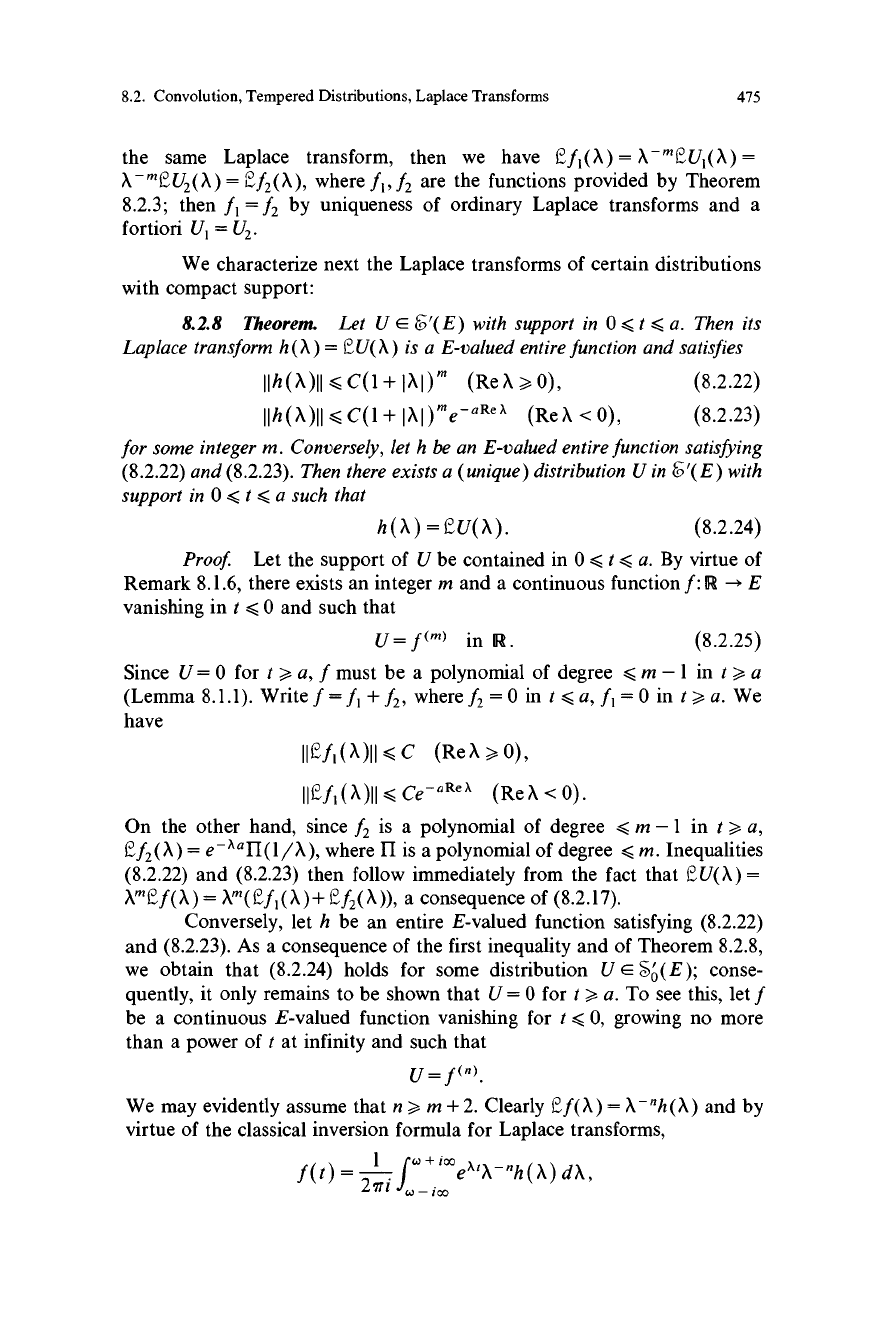
8.2. Convolution, Tempered Distributions, Laplace Transforms
475
the same Laplace transform,
then we have e f, (A) = A- m e U, (A) _
A-mLU2(A) = Lf2(A), where f,, f2 are the functions provided by Theorem
8.2.3; then f, = f2 by uniqueness of ordinary Laplace transforms and a
fortiori U, = U2.
We characterize next the Laplace transforms of certain distributions
with compact support:
8.2.8
Theorem.
Let U E P(E) with support in 0 < t < a. Then its
Laplace transform h(A) = CU(A) is a E-valued entire function and satisfies
Ilh(A)II<C(l+IAI)m
(ReA>0O), (8.2.22)
11h(A)II <C(1+
IAI)me-aRex
(Re X <0),
(8.2.23)
for some integer m. Conversely, let h be an E-valued entire function satisfying
(8.2.22) and (8.2.23). Then there exists a (unique) distribution U in l9'(E) with
support in 0 < t < a such that
h(A) =eU(A). (8.2.24)
Proof Let the support of U be contained in 0 < t < a. By virtue of
Remark 8.1.6, there exists an integer m and a continuous function f : R - E
vanishing in t < 0 and such that
U = f(m)
in R.
(8.2.25)
Since U = 0 for t >- a, f must be a polynomial of degree < m - 1 in t > a
(Lemma 8.1.1). Write f = f, + f2, where f2 = 0 in t < a, f, = 0 in t >, a. We
have
IIefi(A)II<C (ReA,0),
IIef(A)II<Ce-aReX
(ReA<0).
On the other hand, since f2 is a polynomial of degree < m -1 in t >- a,
Lf2(A) = e-laII(l/A), where II is a polynomial of degree < m. Inequalities
(8.2.22) and (8.2.23) then follow immediately from the fact that IU(A) _
AmLf(A)= Am(ef,(A)+E f2(A)), a consequence of (8.2.17).
Conversely, let h be an entire E-valued function satisfying (8.2.22)
and (8.2.23). As a consequence of the first inequality and of Theorem 8.2.8,
we obtain that (8.2.24) holds for some distribution U E ,o(E); conse-
quently, it only remains to be shown that U = 0 for t >, a. To see this, let f
be a continuous E-valued function vanishing for t < 0, growing no more
than a power of t at infinity and such that
U= P).
We may evidently assume that n >- m + 2. Clearly 1f( A) = A - "h (A) and by
virtue of the classical /inversion formula for Laplace transforms,
f(t) =
1
pw+iooeXtA-"h(A)
dA,
27x1
JW
- ioo
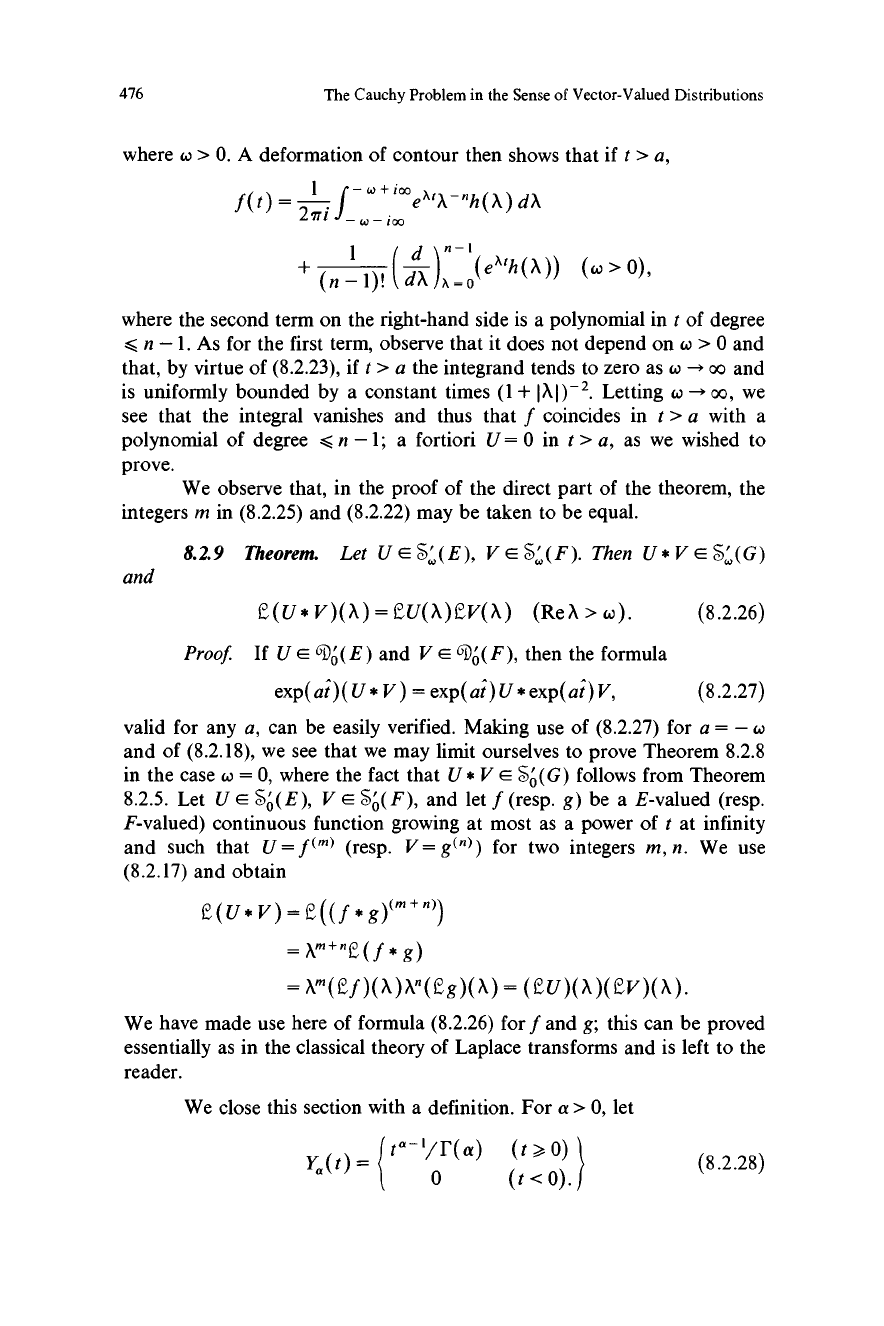
476
The Cauchy Problem in the Sense of Vector-Valued Distributions
where w > 0. A deformation of contour then shows that if t > a,
.f(t) =
27Ii J_w
moo
eXtX-nh(X) A
d "'
+ (n
1
-1)!
()I(exth(x))
(w > 0),
where the second term on the right-hand side is a polynomial in t of degree
n - 1. As for the first term, observe that it does not depend on to > 0 and
that, by virtue of (8.2.23), if t > a the integrand tends to zero as to - co and
is uniformly bounded by a constant times (1 + IXI)-2. Letting to -+ oo, we
see that the integral vanishes and thus that f coincides in t > a with a
polynomial of degree < n - 1; a fortiori U = 0 in t > a, as we wished to
prove.
We observe that, in the proof of the direct part of the theorem, the
integers m in (8.2.25) and (8.2.22) may be taken to be equal.
and
8.2.9 Theorem. Let U E 5W(E), V E 5'(F). Then U * V E 5W(G)
e(U*V)(X)=i'U(x)eV(X) (ReX>w).
(8.2.26)
Proof If U E 6D (E) and V E 6D (F), then the formula
exp(at)(U*V)=exp(ai)U*exp(ai)V, (8.2.27)
valid for any a, can be easily verified. Making use of (8.2.27) for a = - to
and of (8.2.18), we see that we may limit ourselves to prove Theorem 8.2.8
in the case to = 0, where the fact that U * V E 50'(G) follows from Theorem
8.2.5. Let U E 50 '(E), ), V E So (F ), and let f (resp. g) be a E-valued (resp.
F-valued) continuous function growing at most as a power of t at infinity
and such that U = f (m) (resp. V = g(")) for two integers m, n. We use
(8.2.17) and obtain
{
L(U*V)=e((J
*g)(m+n))
_ xm+ne(f * g)
= xm(ef)(X)X"(eg)(X) = (W)(aOV)(X).
We have made use here of formula (8.2.26) for f and g; this can be proved
essentially as in the classical theory of Laplace transforms and is left to the
reader.
We close this section with a definition. For a > 0, let
Y.(t) -
(tom
1
r(a)
t < 0).
}
(8.2.28)
0
(
